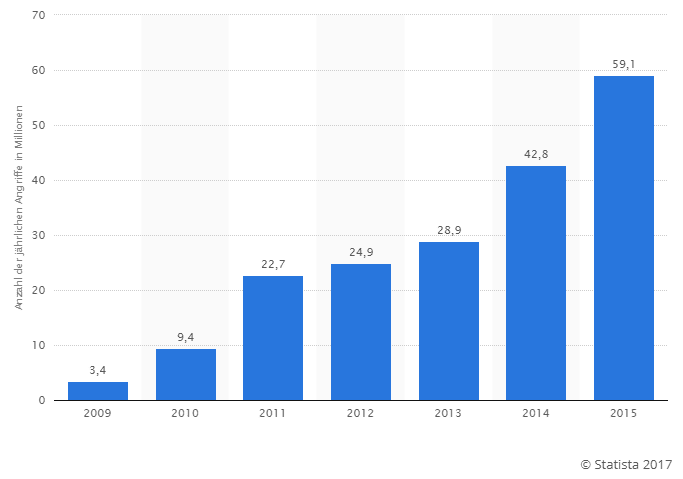[oc_spacer height=”15″]In 2013 around one billion Yahoo accounts were hacked. During this cyber attack, the names, email addresses, telephone numbers as well as birth dates and encrypted passwords of users fell into the hands of cyber criminals. Affected companies, amongst them in recent years even global players such as ebay, Snapchat or Sony, suffered damages totaling millions or even billions. Companies who were subjected to cyber attacks, not only struggled with the huge financial losses, but also suffered with an image problem for years after. Rightly so, if one considers that the privacy of millions of people had been violated.
With the expansion of worldwide internet services, the number of (attempted) online attacks also increases as the raid on data has become a lucrative business. According to estimates, every year hackers make around 400 to 600 million US Dollars by blackmailing private users and companies as well as marketing confidential data.
Carelessness and outdated software leaves the door wide open to hackers
Cyber attacks have become so frequent and wide-ranging, that some providers of cyber security services believe that online data theft would even have to be accepted as part of the economy. More than every second German business has been attacked via the internet over the past two years.
Image 1: Number of annual cyber attacks worldwide in millions
Source: Statista 2017
[oc_spacer height=”15″]According to experts, the most common security vulnerability is still carelessness of internet users. A password derived from their own name, the use of the same login data for various platforms, rare password changes or the good old series of numbers – all this makes phishing simple for online criminals.
However, in many affected organisations, the prevention software was simply obsolete. Outdated browsers or expired operating system – a virus protection alone can no longer withstand the often devious attacks. It is therefore not surprising, that medium sized enterprises with 50 to 100 employees in particular have become victims of hackers. According to German TV channel ZDF, IT departments of large organisations fight up to 6,000 cyber attacks every day. “The threat landscape of cyber attacks is subject to constant change“, says Michael Kranawetter, National Security Officer at Microsoft Germany. “In this digital and therefore highly connected world, it is important to recognise current threat situations in real time and to close vulnerabilities and gateways quickly.“ The internet police of cyber security has to become as imaginative as their criminal counterparts.
Spectacular data thefts and upgrading cyber security
The impact of significant hacking attacks is shocking. But even every small attack is devastating, as the data of the individual is precious and has to be protected from unauthorised access. Due to the ever more frequent cyber attacks, many internet users feel insecure when transmitting personal data online. Whether it is the tax office, the health insurance, shopping, a digital workspace or holiday planning – the internet is expanding into every area of our life. More and more services become quicker and easily available through the internet. Location, credit card information, medical records, private emails: Without sufficient online safeguard mechanisms, attackers are able to completely screen the life of the average internet user.
Not only private users, but also those responsible in businesses are often undecided how to face the growing threat from hacker attacks. According to a study of auditor KPMG, 77% of CEOs see innovation as a vital component of their strategy, although 68% of bosses consider their company ill- prepared for cyber attacks. This is an alarmingly high percentage when you consider the frequency of cyber events.
In Germany, politicians reacted in 2015 by passing the IT Security Act. This attributes a major role to the Federal Office for Information Security in the collection and evaluation of data to fight cyber crime and forces companies to keep “state of the art“ IT security infrastructures. Due to the General Data Protection Regulation from 2018 onwards, companies Europe-wide are also obligated to comply with stricter data protection regulations.
Therefore, it has to be noted that the awareness for the vulnerability of online data has been increasing, not least because of some spectacular data thefts in the past decade. By now, every child should know that “password‘‘ or “1234‘‘ do not deserve the title log-in data. On a political level, already a few measures have been taken to put a stop to the hackers’ game. Additionally, those responsible in companies are increasingly aware of the danger posed by data threats and how to protect their IT structures better from an external malicious invasion.
Protect yourself with oneclick™ from cyber attacks
One tool to protect yourself from malicious attacks is the oneclick™ Application Delivery and Streaming Platform. It shields the existing enterprise network from the internet and the target infrastructure streamed to the user becomes invisible for attackers. Through intelligent systems the platform is effectively protected against external and internal attacks. As standard, oneclick™ has a multi-layered combination of firewall and service-defined network rules.
Another security precaution with oneclick™ is that through backend authentication, no user data and passwords are transmitted to the end device. Through clientless credentials transfer, login is made from the oneclick™ platform and is not transmitted from the client to the application.
With oneclick™ no additional data is collected or saved, instead the platform only enables secure access to the data via the implemented streaming technology. Using oneclick™ you take control over access to your applications and data. It is no longer possible to export unnoticed either customer data or process descriptions.
Protect yourself, your applications, data and networks at the highest level of safety with the tested security of the oneclick™ platform! Find out more about the integrated security in oneclick™ and activate your test account today.
Sources:
- https://de.statista.com/statistik/daten/studie/348766/umfrage/jaehrliche-anzahl-von-internetangriffen-weltweit/
- https://www.computerwoche.de/a/die-groessten-cyberangriffe-auf-unternehmen,3214326
- https://www.cloudcomputing-insider.de/angriffe-auf-die-cloud-nehmen-um-300-prozent-zu-a-635515/?cmp=nl-167&uuid=788786E1-3DFB-43E7-89A3C4E6C37A1D72
- http://www.heute.de/jede-zweite-deutsche-firma-wird-opfer-digitaler-attacken-47725642.html?xing_share=news
- https://www.bsi.bund.de/DE/Themen/Industrie_KRITIS/IT-SiG/Neuregelungen_IT_SiG/neur_IT_SiG_node.html
- https://home.kpmg.com/de/de/home/themen/2015/01/cyber-security.html
- http://hoexter-news.de/wirtschaft/433-%C3%BCber-50-milliarden-euro-umsatz-%E2%80%93-gewinne-der-hacker-schie%C3%9Fen-durch-die-decke-info-veranstaltung-zum-thema-%E2%80%9Eit-sicherheit%E2%80%9C-stie%C3%9F-auf-gro%C3%9Fes-interesse

